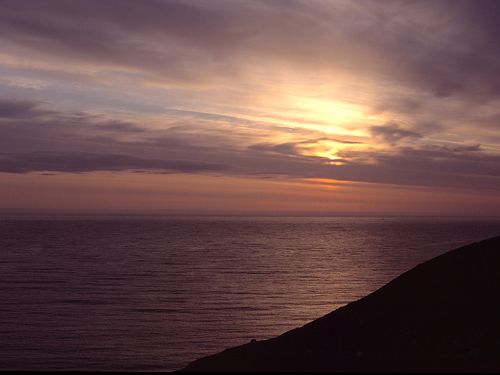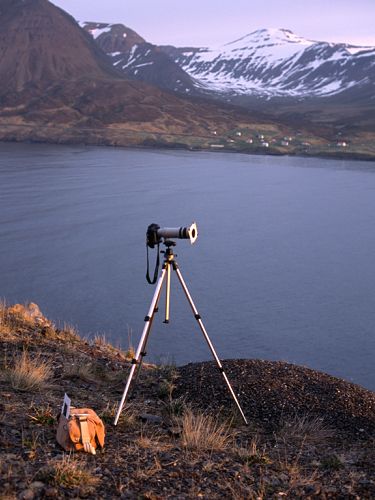|
Ring of Fire Annular Eclipse of the Sun, Iceland, May 31, 2003
Research seemed to indicate that the best chance for good viewing weather during the eclipse would be in northern Iceland, and what better place than the village that advertises its great view of the midnight sun, Ólafsfjörður? Since I am used to seeing the sun more or less to the south, I didn't understand at first that the north coast location also would give a view unimpeded by mountains. One of the weird things about this eclipse is it was at 4:04 a.m. so the sun was to the north-northeast and we viewed it from the "wrong" side of the earth. The shadow of the moon traveled from east to west over the earth, the opposite of most solar eclipses. Going in, I didn't know what an annular eclipse was and how it differed from a total eclipse. The moon's orbit is not circular, so when an eclipse occurs when the moon is near its maximum orbit, it does not completely cover the sun. It is still too bright to look at directly, but viewed through a solar filter, the sun appears as a ring with a giant hole punched out of the middle. The Latin word annulus means ring, so the scientists refer to such an event as an annular eclipse. I also read that a clear view of a total eclipse is much more spectacular than an annular eclipse because all direct sunlight is blocked and the sun's corona can be seen. However, I was thinking later that it was good we "only" had an annular eclipse because a total eclipse is much fainter and it might have been impossible to see anything through the clouds. As it was, the sun/moon broke through at literally the last possible second to provide a faint view of the Ring of Fire. I drove out to the chosen site near town and saw a number of people disembarking from a tour bus. They headed up the mountain on foot. I was very happy with my location right next to my parked car. I mounted the 100-400mm lens, 1.4x extender, and Canon 1D camera on the tripod. The first test shots were completely black, which caused some concern. After slowing down the shutter speed to 1/8, I got my first murky image. I saw a report on Icelandic TV later about the eclipse. Although I didn't understand what they were saying, I got the impression that most of Iceland was afflicted by clouds. The images they showed were no better than what I got. Then they showed a location where people had clear viewing, so I theorized that they must be in Scotland or the Faroes otherwise they would have led with that. It looked like a town park so it certainly didn't look like Greenland, the only other location where the eclipse was visible. Eclipse facts: Annular eclipses are just as common as total eclipses, but probably don't get the publicity because they aren't quite as spectacular. Total eclipses happen because of the remarkable coincidence that the moon is the same apparent size in the sky as the sun. However, the moon is spiraling away from the earth at 1.5 inches per year, so in a few million years there will be no more total eclipses, just annular. Here is the timeline as I observed it from Ólafsfjörður:
If the eclipse had been five minutes later, viewing of the peak would have been much better. But if it had been five minutes earlier, it would have been totally obscured. Many locations in Iceland were obscured from start to finish. So I should be thankful that I got to see as much as I did. (By the way, conditions the previous morning had been ideal. Yes I did get up to check.) As indicated, the photo at the top of the page was taken at the peak. Here are five more photos, two before the peak, two after, and one of my equipment. Photos (except as noted) were cropped from images taken with Canon EOS 1D digital camera set on 200 ISO, 100-400mm zoom set at 400mm, 1.4x extender, solar filter constructed of Thousand Oaks black polymer.
|
Top Menu | Destinations | Years | Species | Aircraft, etc. | Blog | Contact Info
All photos ©1998 - 2026 by Thomas O'Neil





